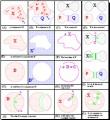
Voting, Arbitration & Fair Division: Mathematics of Social Choice
by Marcus Pivato
Publisher: Trent University 2007
Number of pages: 181
Description:
An introduction to social choice theory, which uses mathematics to study the strengths/weaknesses of voting systems, arbitration schemes, and other methods of group decision making. Lots of pictures, requires only basic linear algebra.
Download or read it online for free here:
Download link
(3MB, PDF)
Similar books
 On 2D Inverse Problems
On 2D Inverse Problems- Wikibooks
This book is about the inverse problems that take its roots in medical imaging and similar imaging methods from geophysics. The study was motivated by the needs of non-destructive and non-intrusive methods for imaging of hidden objects.
(8183 views)
 Math Alive
Math Aliveby Ingrid Daubechies, Shannon Hughes - Princeton University
Designed for those who haven't had college mathematics but would like to understand some applications: Cryptography; Error correction and compression; Probability and Statistics; Birth, Growth, Death and Chaos; Graph Theory; Voting and Social Choice.
(12206 views)
 Mathematical Methods
Mathematical Methodsby Mihir Sen, Joseph M. Powers - University of Notre Dame
Multidimensional calculus, linear analysis, linear operators, vector algebra, ordinary differential equations. Directed at first year graduate students in engineering and undergraduates who wish to become better prepared for graduate studies.
(25396 views)
 Topics in Applied Mathematics and Nonlinear Waves
Topics in Applied Mathematics and Nonlinear Wavesby Per Kristen Jakobsen - arXiv.org
The selection of topics in this text has formed the core of a one semester course in applied mathematics at the Arctic University of Norway. The class has, during its existence, drawn participants from both applied mathematics and physics.
(4428 views)